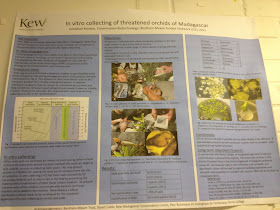Given it was only me, they made an exception to take me into the sterile rooms, which was amazing, and also why I do not have too many pictures: I wanted to keep a low profile - me and my contaminants!
What they do in the lab is to try and propagate plants that do not grow easily from seed (called recalcitrant as they do not store well and are viable only when fresh), and endangered plants, at risk of extinction in the wild.
The preference is always to propagate from seed, so as to maximise genetic diversity and give plants a better chance when they are reintroduced in the wild. However, that is not always necessary, or wanted, for example in the case of clones propagated for some specific characteristics that are used only for amenity purposes. Sometimes, propagating from seed is outright impossible. I was told of plants rescued from the last living clump!
The story of Anogramma ascensionis, the Ascension island parsley fern, rescued from the last four plants located on a steep cliff, is rather fascinating. There's a whole article on this in the Kew magazine.
- Ferns, orchids and bryophytes (I wrote about them last month) for conservation purposes, and
- some plants (regular and carnivorous) to keep the living collections in the gardens going
They are propagated, each one according to a specific protocol based on their requirements, which takes into account anything from the composition of the substrate on which they are grown to the conditions of growing and weaning.
Plant material for which a suitable growing technique has already been developed is cryopreserved in liquid nitrogen, to ensure a state of suspended growth that is not prone to genetic mutations.
I was shown some bryophytes that had been stored on a piece of paper coated with a protective substance, alginate, then coated over again. They have now been taken out of storage, thawed and grown on, to test viability: they were growing in petri dishes. Bryophytes, used to dry conditions in their native environments, suffer less than other plant material from the dessication required for cryopreservation. With other plants, hormone treatment helps improve success rates in thawed samples, for example the use of ABA (abscissic acid), which in nature prepares the plant for winter dormancy.
If you find yourself as drawn into this interesting subject as I was (this was my favourite lab visit at Kew), there is a presentation online, which Margaret, my guide today, prepared on Bryophyte ex-situ conservation at Kew.
Most plant material (embryos extracted from the seeds or plant meristems, for example) is sterilized (with sodium dichloroisocyanurate, effective in low concentrations) and then grown on in a substrate that contains a mix of macro- and micro-nutrients. Each species favours a different mix of minerals and sugars, the latter needed because most plants' cells cannot photosynthesize in the light of the lab. However, sugars attracts all sort of pathogens, so sterile conditions are required.
The substrate of nutrients is made into a jelly with the use of agar for three main reasons:
- any contaminant present in the substrate would thrive in a liquid, much more than in the jelly
- roots need support to grow - in vitro plants do not have great roots anyway (which is one of the main problems when weaning them to real-life conditions) but they need support
- a liquid medium would deprive the roots of oxygen (waterlogging), compromising the success of propagation.

There's always an exception, though. Some plants are grown in liquid medium, especially when great quantities are required. That is the case with the marsh violets (Viola palustris) that Kew have been providing to the Durham Wildlife Trust to help restore the habitat for the declining small pearl-bordered fritillary butterfly.
To avoid waterlogging, a special contraption is used where oxygen is pumped at regular intervals into vessels that look like smoothie glasses, whose bottom is filled with liquid. The level of the medium rises, during pumping, to the level of the plants, located on a disc higher up. After a set amount of time, the level of the medium drops again.
Spoilt as they are in their ideal substrate, either jelly or liquid, and without competition, pests or diseases, plants grow relatively fast and multiply... a side effect for the most successfully propagated species, is the onerous splitting and potting on in jars that staff has to undertake.
In the case of the marsh violets, that side effect is the objective: while they are clones, not genetically diverse, the propagation exercise started with a large enough number of genetically diverse plants from seed, which makes it acceptable in terms of resilience of the species.
Orchids are also an interesting case.
In cultivation, they are so difficult to grow because the seeds do not contain any endosperm (the nutrients that feed the embryo until it is out of the ground and able to photosynthesise). Without endosperm, food must come from other sources, until the first green leaves can produce it for themselves. In the wild, it is mycorrhizal fungi, working in symbiosis with the seeds, that provide food for the embryo. Therefore, the distribution of the orchids is limited to areas where suitable fungi live.
For terrestrial orchids in particular, it is difficult to propagate them from seeds in asymbiotic conditions, as the organic nutrients produced by fungi are difficult to supply in the artificial conditions of the lab. In some cases, the fungi themselves lend a hand. Bags of orchid seeds are buried in the soil, so they get "contaminated" before being taken back to the lab, fungi an all. Not an easy procedure!
Epiphytic orchids, the tropical species growing on trees, are slightly easier to feed in a lab, because they are used to finding inorganic nutrients from washout pools that form when it is raining.
Really fascinating, thanks Margaret for the informative and really enjoyable time you spent teaching me.


No comments:
Post a Comment